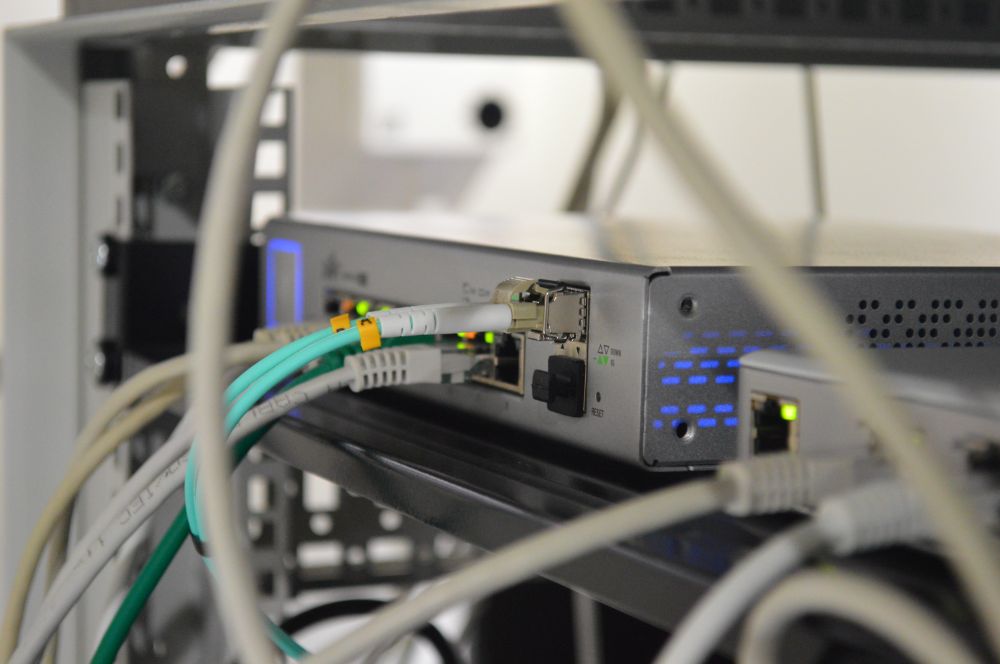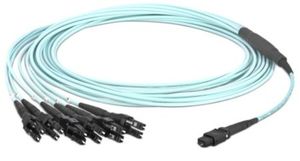Right now you may be considering migrating your network to 40-Gbps Ethernet, largely to support…

What Is An SFP Module And What Is It Used For?
Businesses today need to have robust networking and communication infrastructure. Each element plays a role in sustaining an organization’s technological ecosystem, from towering data centers that power cloud services to the routers and switches that facilitate internet connectivity.
When it comes to networking, one of the most common pieces of equipment is the SFP module, or small form-factor pluggable. This common compact transceiver is designed to transmit and receive data over various communication channels, and it’s a crucial component of modern networking capabilities.
If you’re wondering “What are SFP modules?” and how they might relate to your IT infrastructure, this article is for you. We’ll dive into different elements of SFP modules, including receiver sensitivity, transmitter power, and how SFP modules thrive in diverse industries.
Understanding the basics of SFP modules
What are SFP modules at the most basic level? At its core, an SFP module is a compact, hot-swappable transceiver designed to transmit and receive data over different channels, and they often are central to an organization’s networking capabilities. The “small form factor” refers to these modules’ standardized size and shape, allowing for a consistent and efficient design across different networking devices.
SFP modules are engineered to fit into their respective SFP ports of switches, routers, and other hardware. This design enhances their adaptability, facilitating easy upgrades and replacements without disrupting the entire network.
The purpose of SFP modules
SFP modules play a critical role in modern communication infrastructure. They facilitate speedy, seamless data and telecommunications connections between switches and other devices (routers) through cables (fiber or ethernet).
They’re essential to modern IT infrastructure rooted in data centers. SFP modules play a central role in optimizing connectivity, especially considering the ever-increasing demand for higher bandwidth and lower latency.
Organizations are expected to keep up with the pace of technology and business, and SFP modules can support businesses’ fast-paced digital aspects. This becomes particularly apparent when we consider the speed of internet connectivity today. Even in just the past few years alone, North America’s average WiFi network connection speeds have more than doubled, showing just how normal and expected a high-speed connection has become.
SFP modules are employed in various telecommunications networks, including establishing high-speed links between network nodes, connecting to fiber optic backbones, and facilitating last-mile connectivity. The ability to mix and match compatible SFPs based on specific requirements allows service providers to tailor their networks to the unique needs of different regions and user bases.
Features of SFP modules
SFP modules have very distinct functionalities that dictate how they contribute to enhanced network performance. Aside from their standardized form factor (making them flexible and scalable) and hot-swapability, they are also interchangeable.
SFP modules come in various types to support different data rates, cable types (fiber or copper), and network configurations. This interchangeability allows network administrators to choose the appropriate module for specific applications, contributing to a modular and adaptable network design.
Additionally, SFP modules support a wide range of data rates. Because they adhere to industry standards, they are compatible with a wide range of networking equipment from various manufacturers.
Some other notable features of SFP modules include their receiver sensitivity and transmitter power.
Receiver Sensitivity of SFP Modules
Receiver sensitivity (RX) refers to the minimum signal power that a receiver can interpret to achieve a certain level of performance. If the incoming signal is below that threshold, a receiver might be unable to detect and demodulate the incoming optical signal reliably. The receiver sensitivity is typically specified in terms of the minimum received optical power in decibels referenced to 1 milliwatt (dBm) or sometimes microwatts (dBμW).
There are some general guidelines to keep in mind when regarding the receiver sensitivity of SFP modules, including:
- Typical receiver sensitivity: While receiver sensitivity depends on the module, it can typically fall between anywhere from -9 to -20.
- Higher data rates: As data rates increase, the receiver sensitivity can become more important. SFP modules can support a large range of data rates.
Transmitter Power of SFP Modules
Similarly to receiver sensitivity, the transmitter power (or TX power) measures the signal the module emits. It is an important parameter that influences the reach and performance of the optical link.
Transmitter power is typically specified in terms of optical power in decibels referenced to 1 milliwatt (dBm) or microwatts (dBμW). The specific transmitter power levels can vary based on the module type, the data rate it supports, and the type of optical fiber used.
Types of SFP modules
Depending on whether you’re working with copper connections or fiber optics, there are many different types of SFP modules. If you’re working with copper optics (which are best suited for shorter-distance connections), there are some standard modules for networking you might find, such as 1000BASE-T and 1000BASE-TX modules.
Fiber optics, however, is growing in popularity and is best suited for longer distances. By 2025, the fiber optics market is projected to grow by hundreds of millions of dollars.
There are also two main fiber optic SFP modules: single-mode and multi-mode. They use a color-coded bale clasp system to distinguish them.
Single-Mode SFP Modules
Single-mode SFP modules will only work on single-mode optical fibers. They typically have a smaller core diameter, allowing a smaller, more narrow beam of light. This design enables long-distance transmission.
Multi-Mode SFP Modules
Multi-mode SFP modules will only work on multi-mode optical fibers. They have a larger core diameter, which can limit the distance over which these fibers reliably transmit signals.
SFP modules in different industries
SFP modules find applications across various industries, contributing to efficient and flexible networking solutions. The adaptability and versatility of SFP modules make them suitable for various scenarios.
Implementing SFP Modules in Telecommunications
SFP modules are widely employed in telecommunications networks for tasks such as connecting base stations, multiplexers, and transmission equipment. They facilitate high-speed data transmission over fiber optic networks.
Internet and telecommunications service providers also use them to establish connections, deliver services, and enable high-speed data links. The modular design of SFP modules allows for scalability and adaptability in evolving telecommunications infrastructures.
SFP Modules in Data Center Applications
SFP modules play a crucial role in connecting switches, routers, and other networking equipment within data centers. They are used for high-speed data transmission between servers, storage devices, and network switches. The hot-swappability of SFP modules allows for ongoing maintenance and upgrades, contributing to the agility of data center operations.
Buying SFP modules
When it comes to buying SFP modules, you can choose between new or preowned options. There are pros and cons to both.
Buying New
New SFP modules typically come with a manufacturer’s warranty, and the manufacturer should provide support if there are defects. These models are also less likely to have wear and tear and should come with the latest technology. On the downside, these models can be more expensive, and certain legacy models you want might not be available.
Buying Used
Used SFP modules can be much more cost-effective than new ones, which can be attractive for organizations looking to optimize their IT budget. In some cases, older models of SFP modules may no longer be in production. Buying used modules might be the only option for maintaining or expanding an existing network with older equipment.
While not all used products come with warranties, when you buy from reputable retailers, they’ll come with warranties, care, support tickets, and installation options. For those reasons, it’s important to ensure you’re buying from a trusted third-party reseller who offers the additional services and guarantees you need.
Your Source for Used Networking Equipment
If you’re wondering how we know so much about SFP modules, it’s because networking equipment is what we do best. We’re Network Craze, your source for new and refurbished hardware with over-the-top customer support. We specialize in networking, voice, top-performing cables, maintenance, trade-ins, and SFP modules.
Let us help you get the networking equipment you need at the quality and price your business deserves. Contact us today to get started.



